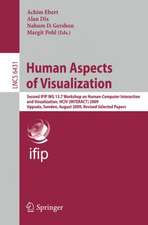People and Computers XIX - The Bigger Picture: Proceedings of HCI 2005
Editat de Tom McEwan, Jan Gulliksen, David Benyonen Limba Engleză Paperback – sep 2005
Preț: 1000.18 lei
Preț vechi: 1250.22 lei
-20% Nou
Puncte Express: 1500
Preț estimativ în valută:
191.38€ • 199.83$ • 158.04£
191.38€ • 199.83$ • 158.04£
Carte tipărită la comandă
Livrare economică 15-29 aprilie
Preluare comenzi: 021 569.72.76
Specificații
ISBN-13: 9781846281921
ISBN-10: 184628192X
Pagini: 510
Ilustrații: XVIII, 510 p. 138 illus.
Dimensiuni: 155 x 235 x 33 mm
Greutate: 0.78 kg
Ediția:2006
Editura: SPRINGER LONDON
Colecția Springer
Locul publicării:London, United Kingdom
ISBN-10: 184628192X
Pagini: 510
Ilustrații: XVIII, 510 p. 138 illus.
Dimensiuni: 155 x 235 x 33 mm
Greutate: 0.78 kg
Ediția:2006
Editura: SPRINGER LONDON
Colecția Springer
Locul publicării:London, United Kingdom
Public țintă
ResearchCuprins
H — HCI at the Human Scale.- “Looking At the Computer but Doing It On Land”: Children’s Interactions in a Tangible Programming Space.- The Usability of Digital Ink Technologies for Children and Teenagers.- PROTEUS: Artefact-driven Constructionist Assessment within Tablet PC-based Low-fidelity Prototyping.- The Reader Creates a Personal Meaning: A Comparative Study of Scenarios and Human-centred Stories.- What Difference Do Guidelines Make? An Observational Study of Online-questionnaire Design Guidelines Put to Practical Use.- Designing Interactive Systems in Context: From Prototype to Deployment.- Using Context Awareness to Enhance Visitor Engagement in a Gallery Space.- Engagement with an Interactive Museum Exhibit.- User Needs in e-Government: Conducting Policy Analysis with Models-on-the-Web.- Fit for Purpose Evaluation: The Case of a Public Information Kiosk for the Socially Disadvantaged.- A Visuo-Biometric Authentication Mechanism for Older Users.- C — HCI in the Greater Cultural Context.- A Computer Science HCI Course.- Use and Usefulness of HCI Methods: Results from an Exploratory Study among Nordic HCI Practitioners.- Building Usability in India: Reflections from the Indo-European Systems Usability Partnership.- Visualizing the Evolution of HCI.- “I thought it was terrible and everyone else loved it” — A New Perspective for Effective Recommender System Design.- Rich Media, Poor Judgement? A Study of Media Effects on Users’ Trust in Expertise.- Cultural Representations in Web Design: Differences in Emotions and Values.- Interaction Design for Countries with a Traditional Culture: A Comparative Study of Income Levels and Cultural Values.- Researching Culture and Usability — A Conceptual Model of Usability.- I — HCI Down at the Interface.-Distinguishing Vibrotactile Effects with Tactile Mouse and Trackball.- HyperGrid — Accessing Complex Information Spaces.- Mixed Interaction Space — Expanding the Interaction Space with Mobile Devices.- Static/Animated Diagrams and their Effect on Students Perceptions of Conceptual Understanding in Computer Aided Learning (CAL) Environments.- Media Co-authoring Practices in Responsive Physical Environments.- Cognitive Model Working Alongside the User.- Revisiting Web Design Guidelines by Exploring Users’ Expectations, Preferences and Visual Search Behaviour.- Comparing Automatic and Manual Zooming Methods for Acquiring Off-screen Targets.- Forward and Backward Speech Skimming with the Elastic Audio Slider.- Design Patterns for Auditory Displays.- Closing Keynote of HCI2005: The Bigger Picture.- Grand Challenges in HCI: the Quest for Theory-led Design.
Textul de pe ultima copertă
This volume contains the full papers presented at HCI 2005, the 19th Annual Conference of the British HCI Group, a specialist group of the BCS. The conference has become the premiere annual conference on human-computer interaction in Europe, attracting a global audience.
People and Computers XIX includes leading edge discussions outlining the latest research results and novel systems from the foremost research and development groups and laboratories throughout the world. In keeping with our theme, The Bigger Picture, this year our authors collectively construct a broad canvas, though we can focus on HCI at three distinct levels:
• The Human Scale – exploring the relationships between individuals mediated by tangible interfaces, ways of capturing their requirements and eliciting their needs, and considering the user in their immediate, local situations
• The Cultural Context – zooming out to gain a perspective on HCI’s place in the world and its relationship with external communities across different countries and cultures, seeing patterns in social networks both within the HCI community and with other stakeholders
• Interactivity at the Interface – here we zoom back in to the detailed level, the traditional territory of HCI, with analysis of interface components and human senses, and the fit between them.
We conclude with the call to action by our closing keynote, Professor Alistair Sutcliffe, who makes the connections to enable the HCI community to meet grand challenges in computer science.
The papers presented in this volume include contributions from leading figures in both the research and business sectors.
People and Computers XIX includes leading edge discussions outlining the latest research results and novel systems from the foremost research and development groups and laboratories throughout the world. In keeping with our theme, The Bigger Picture, this year our authors collectively construct a broad canvas, though we can focus on HCI at three distinct levels:
• The Human Scale – exploring the relationships between individuals mediated by tangible interfaces, ways of capturing their requirements and eliciting their needs, and considering the user in their immediate, local situations
• The Cultural Context – zooming out to gain a perspective on HCI’s place in the world and its relationship with external communities across different countries and cultures, seeing patterns in social networks both within the HCI community and with other stakeholders
• Interactivity at the Interface – here we zoom back in to the detailed level, the traditional territory of HCI, with analysis of interface components and human senses, and the fit between them.
We conclude with the call to action by our closing keynote, Professor Alistair Sutcliffe, who makes the connections to enable the HCI community to meet grand challenges in computer science.
The papers presented in this volume include contributions from leading figures in both the research and business sectors.
Caracteristici
Proceedings of the 19th annual Human-Computer Interaction conference, organised by the British HCI Group

























